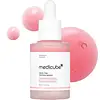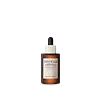What's inside
What's inside
 Key Ingredients
Key Ingredients

 Benefits
Benefits

 Concerns
Concerns

 Ingredients Side-by-side
Ingredients Side-by-side

Water
Skin ConditioningGlycerin
HumectantDipropylene Glycol
HumectantIsopropyl Myristate
EmollientGlycereth-26
Humectant1,2-Hexanediol
Skin ConditioningNiacinamide
SmoothingButylene Glycol
HumectantPolyglycerin-3
HumectantAcrylates/C10-30 Alkyl Acrylate Crosspolymer
Emulsion StabilisingTromethamine
BufferingSodium Acrylate/Sodium Acryloyldimethyl Taurate Copolymer
Emulsion StabilisingGlyceryl Acrylate/Acrylic Acid Copolymer
HumectantPolyisobutene
Pvm/Ma Copolymer
Emulsion StabilisingEthylhexylglycerin
Skin ConditioningCaprylyl Glycol
EmollientParfum
MaskingAdenosine
Skin ConditioningMelia Azadirachta Leaf Extract
Skin ConditioningSodium Phytate
Sodium Hyaluronate
HumectantMelia Azadirachta Flower Extract
Skin ConditioningCurcuma Longa Root Extract
MaskingCyanocobalamin
Skin ConditioningUbiquinone
AntioxidantSorbitan Oleate
EmulsifyingCaprylyl/Capryl Glucoside
CleansingRosa Damascena Extract
MaskingSodium Dna
Skin ConditioningOcimum Sanctum Leaf Extract
Skin ConditioningDisodium EDTA
Corallina Officinalis Extract
Skin ConditioningAcetyl Hexapeptide-8
HumectantCopper Tripeptide-1
Skin ConditioningPalmitoyl Tripeptide-1
Skin ConditioningPalmitoyl Tetrapeptide-7
Skin ConditioningPalmitoyl Pentapeptide-4
Skin ConditioningWater, Glycerin, Dipropylene Glycol, Isopropyl Myristate, Glycereth-26, 1,2-Hexanediol, Niacinamide, Butylene Glycol, Polyglycerin-3, Acrylates/C10-30 Alkyl Acrylate Crosspolymer, Tromethamine, Sodium Acrylate/Sodium Acryloyldimethyl Taurate Copolymer, Glyceryl Acrylate/Acrylic Acid Copolymer, Polyisobutene, Pvm/Ma Copolymer, Ethylhexylglycerin, Caprylyl Glycol, Parfum, Adenosine, Melia Azadirachta Leaf Extract, Sodium Phytate, Sodium Hyaluronate, Melia Azadirachta Flower Extract, Curcuma Longa Root Extract, Cyanocobalamin, Ubiquinone, Sorbitan Oleate, Caprylyl/Capryl Glucoside, Rosa Damascena Extract, Sodium Dna, Ocimum Sanctum Leaf Extract, Disodium EDTA, Corallina Officinalis Extract, Acetyl Hexapeptide-8, Copper Tripeptide-1, Palmitoyl Tripeptide-1, Palmitoyl Tetrapeptide-7, Palmitoyl Pentapeptide-4
Centella Asiatica Extract
CleansingButylene Glycol
HumectantGlycerin
HumectantWater
Skin ConditioningPropanediol
SolventCaprylic/Capric Triglyceride
MaskingNiacinamide
SmoothingLactobacillus/Centella Asiatica Extract Ferment Filtrate
Skin Conditioning1,2-Hexanediol
Skin ConditioningDipropylene Glycol
HumectantPolyglyceryl-3 Distearate
EmulsifyingAcrylates/C10-30 Alkyl Acrylate Crosspolymer
Emulsion StabilisingC14-22 Alcohols
Emulsion StabilisingArginine
MaskingHydrogenated Lecithin
EmulsifyingBetaine
HumectantAllantoin
Skin ConditioningPanthenol
Skin ConditioningHydroxystearic Acid
CleansingEthylhexylglycerin
Skin ConditioningHydroxyethyl Acrylate/Sodium Acryloyldimethyl Taurate Copolymer
Emulsion StabilisingGlyceryl Stearate Citrate
EmollientSodium Polyacrylate
AbsorbentAdenosine
Skin ConditioningC12-20 Alkyl Glucoside
EmulsifyingCetearyl Alcohol
EmollientXanthan Gum
EmulsifyingMacadamia Ternifolia Seed Oil
EmollientSodium Phytate
Sodium Hyaluronate
HumectantStearic Acid
CleansingCeramide NP
Skin ConditioningGlyceryl Acrylate/Acrylic Acid Copolymer
HumectantSorbitan Isostearate
EmulsifyingPolyglyceryl-10 Myristate
Skin ConditioningMadecassic Acid
Skin ConditioningAsiaticoside
AntioxidantPhytosphingosine
Skin ConditioningAsiatic Acid
Skin ConditioningSucrose Distearate
EmollientPolyglutamic Acid
Skin ConditioningGlucose
HumectantLauric Acid
CleansingPhytosterols
Skin ConditioningCentella Asiatica Extract, Butylene Glycol, Glycerin, Water, Propanediol, Caprylic/Capric Triglyceride, Niacinamide, Lactobacillus/Centella Asiatica Extract Ferment Filtrate, 1,2-Hexanediol, Dipropylene Glycol, Polyglyceryl-3 Distearate, Acrylates/C10-30 Alkyl Acrylate Crosspolymer, C14-22 Alcohols, Arginine, Hydrogenated Lecithin, Betaine, Allantoin, Panthenol, Hydroxystearic Acid, Ethylhexylglycerin, Hydroxyethyl Acrylate/Sodium Acryloyldimethyl Taurate Copolymer, Glyceryl Stearate Citrate, Sodium Polyacrylate, Adenosine, C12-20 Alkyl Glucoside, Cetearyl Alcohol, Xanthan Gum, Macadamia Ternifolia Seed Oil, Sodium Phytate, Sodium Hyaluronate, Stearic Acid, Ceramide NP, Glyceryl Acrylate/Acrylic Acid Copolymer, Sorbitan Isostearate, Polyglyceryl-10 Myristate, Madecassic Acid, Asiaticoside, Phytosphingosine, Asiatic Acid, Sucrose Distearate, Polyglutamic Acid, Glucose, Lauric Acid, Phytosterols
 Reviews
Reviews

Ingredients Explained
These ingredients are found in both products.
Ingredients higher up in an ingredient list are typically present in a larger amount.
1,2-Hexanediol is a synthetic liquid and another multi-functional powerhouse.
It is a:
- Humectant, drawing moisture into the skin
- Emollient, helping to soften skin
- Solvent, dispersing and stabilizing formulas
- Preservative booster, enhancing the antimicrobial activity of other preservatives
Acrylates/C10-30 Alkyl Acrylate Crosspolymer is a synthetic polymer. It is used to thicken and improve the texture of products. Due to its properties, it can prevent water and oil ingredients from separating.
Adenosine is in every living organism. It is one of four components in nucleic acids that helps store our DNA.
Adenosine has many benefits when used. These benefits include hydrating the skin, smoothing skin, and reducing wrinkles. Once applied, adenosine increases collagen production. It also helps with improving firmness and tissue repair.
Studies have found adenosine may also help with wound healing.
In skincare products, Adenosine is usually derived from yeast.
Learn more about AdenosineButylene Glycol (or BG) is used within cosmetic products for a few different reasons:
Overall, Butylene Glycol is a safe and well-rounded ingredient that works well with other ingredients.
Though this ingredient works well with most skin types, some people with sensitive skin may experience a reaction such as allergic rashes, closed comedones, or itchiness.
Learn more about Butylene GlycolDipropylene Glycol is a synthetically created humectant, stabilizer, and solvent.
This ingredient helps:
Dipropylene glycol is technically an alcohol, but it belongs to the glycol family (often considered part of the ‘good’ alcohols). This means it is hydrating and gentle on skin unlike drying solvent alcohols like denatured alcohol.
As a masking agent, Dipropylene Glycol can be used to cover the smell of other ingredients. However, it does not have a scent.
Studies show Dipropylene Glycol is considered safe to use in skincare.
Learn more about Dipropylene GlycolEthylhexylglycerin (we can't pronounce this either) is commonly used as a preservative and skin softener. It is derived from glyceryl.
You might see Ethylhexylglycerin often paired with other preservatives such as phenoxyethanol. Ethylhexylglycerin has been found to increase the effectiveness of these other preservatives.
Glycerin is already naturally found in your skin. It helps moisturize and protect your skin.
A study from 2016 found glycerin to be more effective as a humectant than AHAs and hyaluronic acid.
As a humectant, it helps the skin stay hydrated by pulling moisture to your skin. The low molecular weight of glycerin allows it to pull moisture into the deeper layers of your skin.
Hydrated skin improves your skin barrier; Your skin barrier helps protect against irritants and bacteria.
Glycerin has also been found to have antimicrobial and antiviral properties. Due to these properties, glycerin is often used in wound and burn treatments.
In cosmetics, glycerin is usually derived from plants such as soybean or palm. However, it can also be sourced from animals, such as tallow or animal fat.
This ingredient is organic, colorless, odorless, and non-toxic.
Glycerin is the name for this ingredient in American English. British English uses Glycerol/Glycerine.
Learn more about GlycerinGlyceryl Acrylate/Acrylic Acid Copolymer is made up of glycerin and polyacrylic acid. It helps hydrate your skin as a humectant.
This ingredient forms a hydrogel that delivers moisturizing, water-based ingredients to the skin. It is also used to thicken a product and to give it a smooth texture.
Acrylic acid itself is toxic, but the polymer form (this ingredient) is too large to penetrate skin, making it non-toxic.
Learn more about Glyceryl Acrylate/Acrylic Acid CopolymerNiacinamide is a multitasking form of vitamin B3 that strengthens the skin barrier, reduces pores and dark spots, regulates oil, and improves signs of aging.
And the best part? It's gentle and well-tolerated by most skin types, including sensitive and reactive skin.
You might have heard of "niacin flush", or the reddening of skin that causes itchiness. Niacinamide has not been found to cause this.
In very rare cases, some individuals may not be able to tolerate niacinamide at all or experience an allergic reaction to it.
If you are experiencing flaking, irritation, and dryness with this ingredient, be sure to double check all your products as this ingredient can be found in all categories of skincare.
When incorporating niacinamide into your routine, look out for concentration amounts. Typically, 5% niacinamide provides benefits such as fading dark spots. However, if you have sensitive skin, it is better to begin with a smaller concentration.
When you apply niacinamide to your skin, your body converts it into nicotinamide adenine dinucleotide (NAD). NAD is an essential coenzyme that is already found in your cells as "fuel" and powers countless biological processes.
In your skin, NAD helps repair cell damage, produce new healthy cells, support collagen production, strengthen the skin barrier, and fight environmental stressors (like UV and pollution).
Our natural NAD levels start to decline with age, leading to slower skin repair, visible aging, and a weaker skin barrier. By providing your skin niacinamide, you're recharging your skin's NAD levels. This leads to stronger, healthier, and younger looking skin.
Another name for vitamin B3 is nicotinamide. This vitamin is water-soluble and our bodies don't store it. We obtain Vitamin B3 from either food or skincare. Meat, fish, wheat, yeast, and leafy greens contain vitamin B3.
The type of niacinamide used in skincare is synthetically created.
Learn more about NiacinamideSodium Hyaluronate is hyaluronic acid's salt form. It is commonly derived from the sodium salt of hyaluronic acid.
Like hyaluronic acid, it is great at holding water and acts as a humectant. This makes it a great skin hydrating ingredient.
Sodium Hyaluronate is naturally occurring in our bodies and is mostly found in eye fluid and joints.
These are some other common types of Hyaluronic Acid:
Learn more about Sodium HyaluronateSodium Phytate is the synthetic salt form of phytic acid. Phytic acid is an antioxidant and can be found in plant seeds.
Sodium Phytate is a chelating agent. Chelating agents help prevent metals from binding to water. This helps stabilize the ingredients and the product.
Water. It's the most common cosmetic ingredient of all. You'll usually see it at the top of ingredient lists, meaning that it makes up the largest part of the product.
So why is it so popular? Water most often acts as a solvent - this means that it helps dissolve other ingredients into the formulation.
You'll also recognize water as that liquid we all need to stay alive. If you see this, drink a glass of water. Stay hydrated!
Learn more about Water